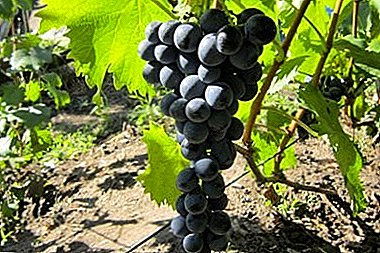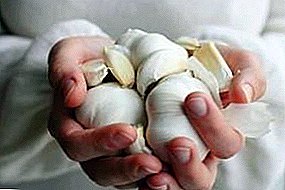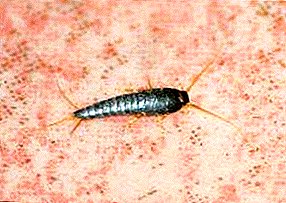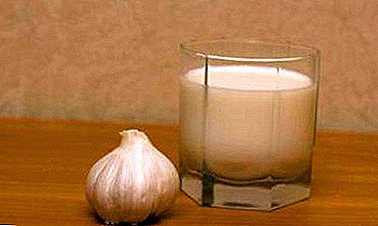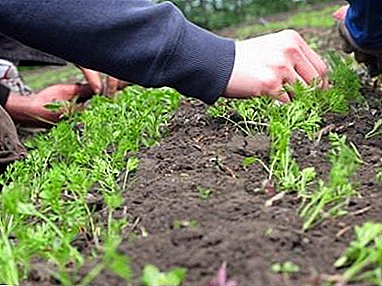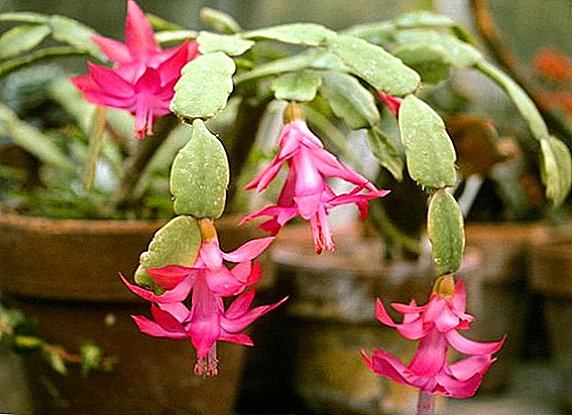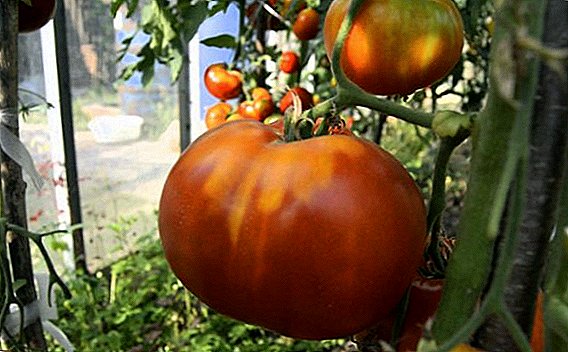 Currently, a sufficiently large number of varieties of tomatoes with large fruits. But even among the giant tomatoes there are unique ones.
Currently, a sufficiently large number of varieties of tomatoes with large fruits. But even among the giant tomatoes there are unique ones.
If you want to grow a crop in which from 1 fruit you can make a salad for a large family, then you should opt for the variety "Shuntuk giant".
Variety description
As the name implies, the fruits are distinguished by their large size. Suitable for growing in greenhouses, and for open ground, needs a garter. In the south of Russia and the whole territory of Ukraine it grows quite normally in open ground. But in the rest of the territory of the Russian Federation and in Belarus, the plant will feel better in the greenhouse, although it will give a harvest in the open air.
Refers to indeterminantnyh varieties, the bush is able to grow by more than 2 meters. Stems are strong, powerful, so as not to grow, it is advisable to form one trunk from them. In one inflorescence 4-6 ovaries form, but in order for the tomatoes to grow as large as possible, two ovaries should be left on one hand.
Important! “Shuntuk giant” is not a hybrid, but a variety of tomatoes. This means that the seeds of the fruits grown by you fully preserve the hereditary characteristics, which means they are suitable for planting.
The fleshy fruit is red, has up to 10 seed chambers. The shape of the fruit is round, slightly flattened above and below. The lower the inflorescences with the fruits, the less seeds in tomatoes. Around the stalk, until the tomato is fully ripe, there is a dark green spot.  Among the advantages of the variety are the following:
Among the advantages of the variety are the following:
- large fruits;
- great appearance;
- quite high yield;
- pleasant fleshy consistency;
- excellent product and taste qualities;
- well tolerated transportation and storage;
- resistant to pests and fungal diseases.
Did you know? The largest tomato, listed in the Guinness Book of Records, was grown in 1986 by G. Graham from Oklahoma. The fruit had a mass of over 3.5 kg. This gardener-record holder has grown a tomato bush, which had a height of more than 16 meters. This bush in less than 1 year gave birth to more than 12,300 fruits.
Fruit characteristics and yield
- fruit weight - 440-480 g, if you do not tear off the inflorescences, if you leave 2 ovaries in the inflorescence, the weight can reach 750-1450 g;
- yield - 13 kg / sq. m;
- early maturity - mid-season;
- ripening terms - 110-114 days from the first shoots;
- purpose - use in raw form, processing;

Selection of seedlings
This procedure should be approached very responsibly, having the necessary stock of knowledge for the correct selection of seedlings. The most acceptable option is to purchase seedlings from a trusted supplier.
If among your friends there is no such person, you will have to visit the market. There is always a risk in the market to purchase low-quality seedlings, but by following some simple recommendations, you can minimize this risk:
- First, ask the seller about his seedlings, about the variety of tomatoes. A person who is truly enthusiastic will immediately begin to tell you about tomatoes, meaningfully answer all your questions. Such gardeners can be trusted, they usually trade in high-quality material, for them the main thing is not money (although, of course, the money will not be superfluous either), but recognition of the “own brand”. Such people will not give out bad seedlings (or other variety) for quality, reputation for them more.
- The age of seedlings should not exceed 45-50 days. All bushes should be about the same height, in this case, fruiting will occur at about the same time.
- The recommended growth of a seedling is 35-40 cm, there should be 9-12 developed leaves on the stem.
- On the stem and roots should not be a trace of dryness, stains, pigmentation.
- Leaves should be the correct form, look healthy, do not have a trace of lethargy.
- If the foliage is hanging, and the color of the seedlings differs in unnatural emerald intensity, it is likely that growth stimulants were used in excessively large doses.
- The seedling should be in containers with the substrate, in the root zone the substrate should be moistened.

Growing conditions
To grow tomatoes best on sandy and clay soils. Under the beds choose a place that is closed from drafts, with good natural lighting, but so that the direct sunlight does not fall on the bushes.
Read more about vegetable crop rotation.
For tomatoes, fruit are very important. Tomatoes grow well after:
- Luke;
- beets;
- carrots.
 Can be planted after:
Can be planted after:- radish;
- cucumbers.
 And after these crops, tomatoes take root badly:
And after these crops, tomatoes take root badly:- legumes;
- pumpkin, with the exception of cucumbers;
- Tomatoes
- soil -14 ° C;
- air in the afternoon - 23-25 ° C;
- air at night - not lower than 14 ° С.
Important! Watering the tomatoes requires abundant and regular: if the amount of precipitation is moderate, water every 4-5 days. Overcooling of roots is unacceptable, with the expected decrease in temperature in the spring, the root area is mulched.
Seed preparation and planting
55-60 days before planting in open ground seedlings need to sow the seeds for seedlings. In order to know the specific date of sowing, use the following calculations:
- Find out with the help of the gardener's calendar, at what time in the area of your residence the air and soil warm up to the above temperatures (air: day - 23-25 ° C; night - 14 ° C and above, soil - 14 ° C);
- from the time suitable for planting tomatoes in the ground, you should subtract 8 weeks, the result is an approximate date of sowing of seeds for seedlings.
- for disinfection put in a solution of potassium permanganate (1 g / 100 ml of water) for 20 minutes;
- for the same purpose, you can soak 1 day in a solution of baking soda of the same concentration;
- treat with Phytosporin - growth stimulator, as indicated in the instructions.
 Now you need to prepare the substrate. If you decide to make it yourself (you can buy ready-made mixture for seedlings in a specialized store), use the following compositions:
Now you need to prepare the substrate. If you decide to make it yourself (you can buy ready-made mixture for seedlings in a specialized store), use the following compositions:
- peat - 1/3;
- turf - 1/3;
- sand - 1/3.
- superphosphate - 1 tbsp. spoon;
- potassium sulfate - 2 tsp;
- urea - 1 tbsp. spoon.
Did you know? In 800 years BC, the natives of Central and South America were already growing tomatoes. The Aztecs gave the culture the name "tomato", or "large berry". Europeans became acquainted with tomatoes in the 16th century, thanks to conquistadors.You can connect in equal parts humus, peat and sod land, mix thoroughly. In a bucket of the mixture to make a tablespoon of superphosphate and 1 cup sifted wood ash.
The soil for seedlings must be heat treated.  This must be done, regardless of where the soil was taken - bought in a store or mixed independently. Below are 3 of the easiest and most effective methods of home disinfection at home:
This must be done, regardless of where the soil was taken - bought in a store or mixed independently. Below are 3 of the easiest and most effective methods of home disinfection at home:
- Pour 3-5 cm in an even layer on a baking sheet, place in the oven for 20 minutes at 200 ° C.
- Spill a solution of potassium permanganate in boiling water.
- Two-minute heating in the microwave, at maximum power.
When the seeds and soil are ready, it's time to sow. For growing seedlings it is best to use peat cups, but you can do with plastic (500 ml), with holes in the bottom for drainage.  2 days before sowing in the glasses pour the soil, it should "heal" slightly. The next day, if this is necessary, the soil should be watered (before planting the seeds, it should be slightly moistened) with warm water.
2 days before sowing in the glasses pour the soil, it should "heal" slightly. The next day, if this is necessary, the soil should be watered (before planting the seeds, it should be slightly moistened) with warm water.
In the ground with a finger we make a depression (1-1.5 cm), where we place the seed. Sprinkle with earth, spray it with a spray bottle, cover it tightly with film.
We recommend to know the better to feed the seedlings of tomatoes.
Until the shoots appeared, the main factors that should be controlled are the temperature, it should be between 23-25 ° C, and the humidity (the soil should be slightly damp).
After the emergence of seedlings, in addition to temperature and humidity, good illumination becomes an equally important parameter. Choose a place for seedlings on a well-lit window sill, but so that there is no drafts.  After 2 days after sowing, it will be necessary to daily remove the film for a short time (for 6-8 minutes) so that the seeds do not suffocate. The humidity of the air inside the glasses is determined by the presence of perspiration on the inside of the film. If it is, then the soil is properly moistened. However, it is necessary to moisturize in moderation so that the soil does not turn into dirt. When shoots appear (5-7 days), the film is removed.
After 2 days after sowing, it will be necessary to daily remove the film for a short time (for 6-8 minutes) so that the seeds do not suffocate. The humidity of the air inside the glasses is determined by the presence of perspiration on the inside of the film. If it is, then the soil is properly moistened. However, it is necessary to moisturize in moderation so that the soil does not turn into dirt. When shoots appear (5-7 days), the film is removed.
Maintenance and care
When creating favorable conditions (temperature, soil and air humidity, lighting), seedlings will appear fairly quickly, and will surely increase in growth.
As soon as the weather is sunny, you can begin to harden the seedlings. The procedure should be carried out on windless days. Open the windows for a few minutes, you can start with a five-minute session. Wait for the next fine day, repeat the manipulation, adding a couple of minutes, continue in the same way.
Find out when it is best to plant tomatoes in open ground.
By the time the seedlings reach the size needed for planting into the ground, and the soil and air have warmed to the right temperature, you should already have the beds ready. The soil for the tomatoes should have been prepared since autumn. To do this, they dig up the place for the beds, remove weeds and fertilize them:
- humus - 4l / 1 square. m;
- superphosphate - 2 tbsp. spoons / 1 square. m;
- potassium salt - 1 tbsp. spoons / 1 square. m
In the event that the soil is acidic, lime should be added - 0.5 kg / 1 sq. M. m  In the spring, 2 weeks before planting the seedlings, the soil is fertilized as follows:
In the spring, 2 weeks before planting the seedlings, the soil is fertilized as follows:
- watering the beds with a solution of chicken (pigeon) litter - 0.5 kg / 1 square. m;
- watered with a solution of sifted wood ash - 0.5 kg / 1 square. m;
- pour a solution of ammonium sulphate - 1 tbsp. spoon / 1 square. m
Only the mass of fertilizers required for processing 1 square. meter, the amount of water can vary. If the soil is sufficiently moistened, enough 1 bucket per 1 square. m (for each type of fertilizer), if dry, the specified number of dressings is dissolved in a larger volume of liquid (1.5-2 buckets).
The beds are arranged according to the following scheme:
- inter-row spacing - 0.5 m;
- distance between the bushes - 0.4 m;
- density - 3-4 bush / 1 square. m;
- location - chess order.
On the prepared fertilized soil, 3 days before planting, the wells are made according to the above scheme. The hole should be of such a size that a peat cup or root with a lump of substrate can fit inside it, if the seedlings are grown in a disposable cup.
Did you know? For a long time, tomatoes were classified as poisonous plants, such as potatoes, of which South America is also the birthplace. Colonel R.G. Johnson, who ate a bucket of tomatoes in 1820 in front of the court building in New Jersey, managed to change the attitude of people towards this culture.Finished wells are spilled with boiling water with potassium permanganate (10 g / 1 bucket of water), then shed with clean hot water and covered with garden film. The film is removed the day before landing.
The procedure of planting seedlings in the ground is quite simple, you should only carefully remove the plant from the glass (if you used disposable). This should be done in such a way that the clod of soil remains intact. If you use peat cups, you do not need to extract anything, plant the plant in the hole with a capacity. In order to facilitate this operation, the day before planting on the garden water the seedlings.  For landing it is better to choose a cloudy, but windless day.
For landing it is better to choose a cloudy, but windless day.
- The plant is placed in the hole so that the neck of the root system is located 2-3 cm above the level of the edge of the hole.
- Try to place the bush in the hole so that the roots do not go into depth (the ground there may still be quite cold), but branch out in a horizontal plane;
- Supporting a bush in an upright position with one hand, with the other, fill the hole with earth, periodically tamping the root zone.
- Water the bushes with warm water. If you did everything correctly, after 4-5 days the roots will already be firm enough to hold and feed the bush.
Video: Planting tomato seedlings in open ground Tomatoes are quite moisture-loving plants. For this reason, some novice gardeners believe that they should be watered as often as possible. This is not entirely true; this variety should be watered as needed, but abundantly.
Need to focus on the state of the soil and rainfall. If the soil is dry (it is better not to bring it up), watering is necessary. If hydrated enough, it is better to wait with water treatments.
Important! In the event that your seedlings have already reached the conditions necessary for planting in the open ground, and the soil and air have not warmed enough, put the seedlings in a cool place and minimize watering. Thanks to this measure, growth will slow down, and when favorable conditions occur, plant the plants in the ground. It is not necessary to be afraid, the method is absolutely not dangerous, in normal conditions the tomato will start growing quickly.On average, with enough rainfall, need weekly watering. If there is little rain, the procedure is carried out every 4 days. In the event that the summer was rainy, for quite a long time you can do without irrigation.
 Water procedures for tomatoes need to arrange either in the early morning, or in the hours before sunset (the best option). For watering, you need to use a garden watering can and be sure to have warm settled or rain water. Another best solution would be drip irrigation equipment. Try to water the plants in such a way that the water gets only in the root area, not leaving a washout in the soil.
Water procedures for tomatoes need to arrange either in the early morning, or in the hours before sunset (the best option). For watering, you need to use a garden watering can and be sure to have warm settled or rain water. Another best solution would be drip irrigation equipment. Try to water the plants in such a way that the water gets only in the root area, not leaving a washout in the soil.Not bad for watering tomatoes filling method. It consists in the following: on both sides of the bed, at a distance of 35-40 cm from the bush, longitudinal trenches are made, 30-35 cm wide, and of the same depth. The ditches are filled with water to the top, the water, being absorbed into the soil, gets into the root system.
You will probably be interested to know whether it is possible to grow tomatoes without watering.
This method is good because the soil is deeply and fairly abundantly saturated with moisture. It is advisable to apply before the plants begin to bear fruit. Approximate consumption - 1 bucket / 1 bush. Fill the trench every 4-7 days, depending on the amount of precipitation.
After each watering should loosen the land between the bushes, as it is covered with a crust. During loosening, as necessary, the beds are also weeded.  The first 3 weeks should be loosened no deeper than 8-10 cm. After this, the loosening depth should be reduced to 6-8 cm, since during the procedure, the root system that has grown by that time can be touched. The clay soil between the rows can be loosened more deeply.
The first 3 weeks should be loosened no deeper than 8-10 cm. After this, the loosening depth should be reduced to 6-8 cm, since during the procedure, the root system that has grown by that time can be touched. The clay soil between the rows can be loosened more deeply.
Did you know? To date, there are over 10 thousand subspecies, varieties and hybrids of tomatoes. The smallest diameter of an adult tomato is barely more than 1.5 cm, typical representatives of the largest varieties (which include "Shuntuk giant") reach 1.5 kg of weight. The palette of colors, in addition to the usual red and pink, includes varieties of black and yellow colors.Do not forget to spud tomatoes. This agrotechnical technique is extremely important for such reasons:
- helps in soil aeration;
- uniform heating of the ground in the root zone;
- prevents the root system from reaching the surface;
- good for the correct growth of roots in the horizontal plane.
The first time spud tomatoes after 3 weeks of cultivation in the garden, a second procedure - after the same time.  Masking is an important agrotechnical device, the main purpose of which is to increase the yield of the plant. The essence of the procedure is to form a bush by removing the side shoots. These shoots do not bear fruit, but the plant spends on them its nutrients, instead of directing these resources to the formation of new ovaries, and, accordingly, the fruits.
Masking is an important agrotechnical device, the main purpose of which is to increase the yield of the plant. The essence of the procedure is to form a bush by removing the side shoots. These shoots do not bear fruit, but the plant spends on them its nutrients, instead of directing these resources to the formation of new ovaries, and, accordingly, the fruits.
If tomatoes are not pasynkovat, they will branch quite intensively. In the sinuses formed lateral processes, which are called stepchildren. Removing these shoots, we leave only the branches bearing fruit. The basic rules of pinching:
- As soon as the first brush blooms, you should remove its stepson.
- Shoots pinch, break off or tear off, they should not be cut.
- Remove the stepchildren must be on time, until they reach 4 cm.
- Pinch all stepchildren who are below the lowest branch with the ovaries. On the processes that are above this branch, the appearance of ovaries is possible. They, at your discretion, can be left.
- The procedure is more expedient to carry out in the morning.
 Together with the pinching, remove all the lower leaves that are in contact with the soil.The stem, to the lower branches with ovaries, should be bare, normally illuminated, with good air access.
Together with the pinching, remove all the lower leaves that are in contact with the soil.The stem, to the lower branches with ovaries, should be bare, normally illuminated, with good air access.Important! Leaves of dark green with signs of wilting indicate insufficient watering.The final pinching and pinching the crown is carried out about 1-2 weeks before the end of the summer. Top pinch so that the bush no longer grows.
The indeterminate varieties to which the "Shuntuk giant" belongs, need to be staked. If the shoots are not touched, the bush grows heavily and stretches upwards. This circumstance is an obstacle to the formation of large fruits.
There are several pinching schemes (in 1, 2 or 3 stalks). For the “Shuntuk giant”, a stalk of 1 stem is not suitable, as with such a scheme the bush is strongly drawn up, although large fruits will be born.
Disease and pest prevention
Like most garden crops, tomatoes, even the most resistant to disease, are still susceptible to certain diseases and attack by pests. A few words about the most common ones.
Colorado beetle. Perhaps the most dangerous enemy of tomatoes, feeds on foliage and ovaries. Of the herbicides used to destroy this parasite, we can distinguish the following: Bombardier, Typhoon, and other agents whose active ingredients are imidacloprid and glyphosate. Apply drugs, following the instructions.  It should be mentioned about the methods without the use of chemical preparations: the bushes are sprayed with tincture of wormwood, wood ash. During flowering, sprinkle with sifted birch ash.
It should be mentioned about the methods without the use of chemical preparations: the bushes are sprayed with tincture of wormwood, wood ash. During flowering, sprinkle with sifted birch ash.
Important! "Shuntuk giant" almost 100% resistant to tla and slugs, quite well resists fungal diseases.Medvedka. Usually this parasite can be found in soils with high humidity and with a high content of manure. Characteristically, both mature insects and their larvae are dangerous. By breaking through passages in the soil on tomato beds, parasites destroy the root system, thereby preventing plants from developing normally.
 Destroy insecticides containing imidacloprid (Confidor) and diazinon (Medvetoks). The action of the Medvetokas, in addition to the toxin contained in it, is based on the attraction of the insect to the smell. Carefully read the instructions and act according to it.
Destroy insecticides containing imidacloprid (Confidor) and diazinon (Medvetoks). The action of the Medvetokas, in addition to the toxin contained in it, is based on the attraction of the insect to the smell. Carefully read the instructions and act according to it.Also, do not forget about agrotechnical methods:
- minimize manure use;
- periodically loosen the aisles and the space between the bushes.
Scoop on tomatoes. The caterpillar, and subsequently the butterfly, destroys the ovaries of plants. Some tips on how to destroy the parasite:
- spraying drug Lepidocide every 7 days;
- Detsis is quite effective in the fight against the scoop scoop.
- regular weeding of weeds around bushes;
- every 10 days it is recommended to sprinkle tomatoes with tincture of arrows of garlic;
- spraying tincture of tobacco and wormwood.
 From the diseases of tomatoes it is worth saying a few words about these:
From the diseases of tomatoes it is worth saying a few words about these:White spotting. This disease can be recognized by red spots on the leaves, which subsequently dry up and fall off. At the first sign, the bushes should be sprayed with a 0.1% solution of Bordeaux mixture.
Important! Mushrooms ascomycetes, pathogens of Ramulariasis (white spot), winter on fallen leaves affected by them. So, in order to avoid recurrence of the disease in the next season, all foliage must be carefully collected and burned.Brown spotting (phyllosticosis). On the lower leaves from above appear red spots, on the reverse side - the color of the spots is greenish. If the disease is not treated, the foliage falls off. Spraying of copper sulphate (1% solution) is used for treatment.

Harvesting and Storage
When to begin harvesting, depends on the specific region of cultivation. In Moldova, Ukraine, in the south of Russia in an open ground tomatoes ripen in late July-early August. In central Russia, in Belarus - 2-3 weeks later.
Collect the fruits when they have not yet reached full maturity. Such a measure is aimed at the release of plant resources: it will not give strength to the full maturation of the fetus (which will ripen independently), but will form new ovaries.  As soon as you notice that the plant begins to “fall asleep” (this phenomenon coincides with a decrease in temperature), it is necessary to harvest the rest of the crop. When the night air temperature stably stays within 6-8 ° С, then it does not make sense to keep the fruits on the bushes, they will not “reach”.
As soon as you notice that the plant begins to “fall asleep” (this phenomenon coincides with a decrease in temperature), it is necessary to harvest the rest of the crop. When the night air temperature stably stays within 6-8 ° С, then it does not make sense to keep the fruits on the bushes, they will not “reach”.
Find out why you can not store tomatoes in the refrigerator.
In the event that the onset of frost is felt, and the bushes are still plastered with green tomatoes, the following measures should be taken:
- The bushes are dug together with the root and lay with ricks up to 1 m high, tops in one direction.
- Mounds are covered with straw and left for 1.5-2 weeks. After the indicated time, ripe tomatoes are collected, rot and spoiled fruits are removed.
- Regularly, every 2-3 days, harvest, until all the tomatoes are ripe.
 Not bad this way of ripening:
Not bad this way of ripening:
- Collect any remaining green fruit.
- Lay a garden film on the floor of the greenhouse, put a thin layer of the crop on it, cover it with straw.
- Set the air temperature in the greenhouse at 17-22 ° C, with an average humidity of 75-80%.
- As ripening harvest, remove damage and rot.
Did you know? More than 94% of the tomato is water, 100 g of tomatoes only 22 calories, so it is almost the ideal product for weight loss."Shuntuk giant" absolutely justifies its name, delighting gardeners with huge fruits and unpretentious care. Most amateur gardeners who have tried to grow these giants become their loyal fans. Try to plant this variety in your garden, it is quite possible that you will soon join the “Shuntuk giant” tomato admirers.



